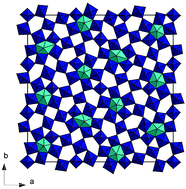Tetragonal tungsten bronzes Nb8−xW9+xO47−δ: optimization strategies and transport properties of a new n-type thermoelectric oxide†
Abstract
Engineering of nanoscaled structures may help controlling the electrical and thermal transport in solids, in particular for thermoelectric applications that require the combination of low thermal conductivity and low electrical resistivity. The tetragonal tungsten bronzes Nb8−xW9+xO47 (TTB) allow a continuous variation of the charge carrier concentration while fulfilling at the same time the concept of a “phonon-glass electron-crystal” through a layered nanostructure defined by intrinsic crystallographic shear planes. The thermoelectric properties of the tetragonal tungsten bronzes Nb8−xW9+xO47−δ (0 < x < 2) were studied in the temperature range from 373 to 973 K. Structural defects and the thermal stability under various oxygen partial pressure pO2 were investigated by means of thermogravimetry, HR-TEM, and XRD. Nb8W9O47−δ was found stable at 973 K and a pO2 of ≈10−15 atm. The oxygen nonstoichiometry δ can reach up to 0.3, depending on the applied atmosphere. By increasing the substitution level x, the electrical resistivity ρ and the Seebeck coefficient S decreased. For x = 2, ρ reached 20 mΩ cm at 973 K, combined with a Seebeck coefficient of approximately −120 μV K−1. The thermal conductivity was low for all samples, ranging from 1.6 to 2.0 W K−1 m−1, attributed to the complex crystal structure. The best thermoelectric figure of merit zT of the investigated samples was 0.043, obtained for x = 2 at 973 K, but it is expected to increase significantly upon a further increase of x. The control of the oxygen non-stoichiometry δ opens a second independent optimization strategy for tetragonal tungsten bronzes.


 Please wait while we load your content...
Please wait while we load your content...